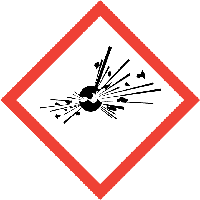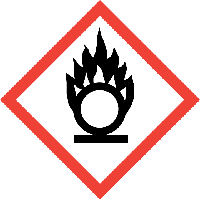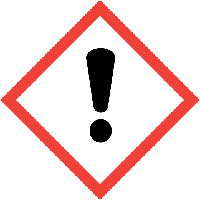CLP Pictograms
-
CLP
- Understanding CLP
- Classification of substances and mixtures
- Labelling and packaging
- Harmonised classification and labelling (CLH)
- New hazard classes 2023
- Alternative chemical name in mixtures
- Understanding Seveso
- C&L Inventory
- Legislation
- The role of testing in CLP
- Enforcement
- Substitution to safer chemicals
- Nanomaterials
- Addressing substances of concern
CLP Pictograms
A hazard pictogram is an image on a label that includes a warning symbol and specific colours intended to provide information about the damage a particular substance or mixture can cause to our health or the environment. The CLP Regulation has introduced a new classification and labelling system for hazardous chemicals in the European Union. The pictograms have also changed and are in line with the United Nations Globally Harmonised System.
Click on the pictograms to reach the relevant description
 Gas under pressure
Gas under pressureSymbol: Gas cylinder

-
What does it mean?
Contains gas under pressure; may explode if heated.
Contains refrigerated gas; may cause cryogenic burns or injury.
Examples of where we can find it
Gas containers
Examples of precautionary statements
Protect from sunlight
Wear cold insulating gloves/face shield/eye protection.
Get immediate medical advice/attention.
-
Symbols that will be phased out:
There is no existing symbol for this hazard pictogram.
 Explosive
ExplosiveSymbol: Exploding bomb

-
What does it mean?
Unstable explosive
Explosive; mass explosion hazard
Explosive; severe projection hazard
Explosive; fire, blast or projection hazard
May mass explode in fire
Examples of where we can find it
Fireworks, ammunition
Examples of precautionary statements
Obtain special instructions before use
Do not handle until all safety precautions have been read and understood
Keep away from heat/sparks/open flames/hot surfaces. – No smoking
Wear protective gloves/protective clothing/eye protection/face protection
Use personal protective equipment as required
Explosion risk in case of fire
-
Symbols that will be phased out:

 Oxidising
OxidisingSymbol: Flame over circle

-
What does it mean?
May cause or intensify fire; oxidiser.
May cause fire or explosion; strong oxidiser.
Examples of where we can find it
Bleach, oxygen for medical purposes -
Examples of precautionary statements
Keep away from heat/sparks/open flames/hot surfaces. – No smoking
Wear protective gloves/protective clothing/eye protection/face protection.
Rinse immediately contaminated clothing and skin with plenty of water before removing clothes.
-
Symbols that will be phased out:

 Flammable
FlammableSymbol: Flame

-
What does it mean?
Extremely flammable gas
Flammable gas
Extremely flammable aerosol
Flammable aerosol
Highly flammable liquid and vapour
Flammable liquid and vapour
Flammable solid
Examples of where we can find it
Lamp oil, petrol, nail polish remover -
Examples of precautionary statements
Do not spray on an open flame or other ignition source.
Keep away from heat/sparks/open flames/hot surfaces – No smoking
Keep container tightly closed
Keep cool
Protect from sunlight
-
Symbols that will be phased out:

 Corrosive
CorrosiveSymbol: Corrosion

-
What does it mean?
May be corrosive to metals
Causes severe skin burns and eye damage
Examples of where we can find it
Drain cleaners, acetic acid, hydrochloric acid, ammoniac -
Examples of precautionary statements
Do not breathe dust/fume/gas/mist/vapours/spray
Wash…thoroughly after handling
Wear protective gloves/protective clothing/eye protection/face protection
Store locked up
Keep only in original container
-
Symbols that will be phased out:


 Health hazard/Hazardous to the ozone layer
Health hazard/Hazardous to the ozone layerSymbol: Exclamation Mark

-
What does it mean?
May cause respiratory irritation
May cause drowsiness or dizziness
May cause an allergic skin reaction
Causes serious eye irritation
Causes skin irritation
Harmful if swallowed
Harmful in contact with skin
Harmful if inhaled
Harms public health and the environment by destroying ozone in the upper atmosphere
Examples of where we can find it
Washing detergents, toilet cleaner, coolant fluid
Examples of precautionary statements
Avoid breathing dust/fume/gas/mist/vapours/spray
Use only outdoors or in a well-ventilated area
If inhaled: remove victim to fresh air and keep at rest in a position comfortable for breathing
If swallowed: call a POISON CENTER or a doctor/physician if you feel unwell
Wear protective gloves/protective clothing/eye protection/face protection.
If on skin: wash with plenty of soap and water
If in eyes: rinse cautiously with water for several minutes. Remove contact lens, if present and easy to do. Continue rinsing.
Do not eat, drink or smoke when using this product.
-
Symbols that will be phased out:

 Acute toxicity
Acute toxicitySymbol: Skulls and Crossbones

-
What does it mean?
Fatal if swallowed
Fatal in contact with skin
Fatal if inhaled
Toxic: if swallowed
Toxic in contact with skin
Toxic if inhaled
Examples of where we can find it
Pesticide, biocide, methanol -
Examples of precautionary statements
Wash... thoroughly after handling.
Do not eat, drink or smoke when using this product.
If swallowed: immediately call a POISON CENTER or a doctor/physician
Rinse mouth
Store in a closed container
Do not get in eyes, on skin, or on clothing.
Wear protective gloves/protective clothing/eye protection/face protection.
If on skin: gently wash with plenty of soap and water
Remove/take off immediately all contaminated clothing.
Wash contaminated clothing before reuse.
Do not breathe dust/fume/gas/mist/vapours/spray.
Use only outdoors or in a well-ventilated area
Wear respiratory protection
If inhaled: Remove victim to fresh air and keep at rest in a position comfortable for breathing
Store locked up
-
Symbols that will be phased out:


 Serious health hazard
Serious health hazardSymbol: Health hazard

-
What does it mean?
May be fatal if swallowed and enters airways
Causes damage to organs
May cause damage to organs
May damage fertility or the unborn child
Suspected of damaging fertility or the unborn child
May cause cancer
Suspected of causing cancer
May cause genetic defects
Suspected of causing genetic defects
May cause allergy or asthma symptoms or breathing difficulties if inhaled
Examples of where we can find it?
Turpentine, petrol, lamp oil
Examples of precautionary statements
If swallowed: immediately call a POISON CENTER or a doctor/physician
Do NOT induce vomiting
Store locked up
Do not breathe dust/fume/gas/mist/vapours/spray.
Wash thoroughly after handling.
Do not eat, drink or smoke when using this product.
Get medical advice/attention if you feel unwell
If exposed: Call a POISON CENTER or doctor/physician
Obtain special instructions before use
Do not handle until all safety precautions have been read and understood
Use personal protective equipment as required
If exposed or concerned: Get medical advice/attention
Avoid breathing dust/fume/gas/mist/vapours/spray
In case of inadequate ventilation wear respiratory protection
If inhaled: If breathing is difficult, remove victim to fresh air and keep at rest in a position comfortable for breathing
-
Symbols that will be phased out:


 Hazardous to the environment
Hazardous to the environmentSymbol: Environment

-
What does it mean?
Very toxic to aquatic life with long lasting effects
Toxic to aquatic life with long lasting effects
Examples of where we can find it?
Pesticides, biocides, petrol, turpentine
Examples of precautionary statements
Avoid release to the environment
Collect spillage
-
Symbols that will be phased out:




